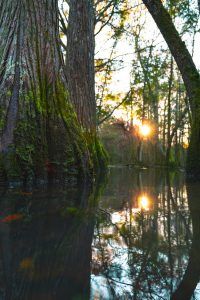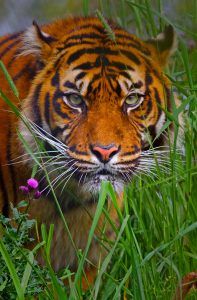Equatorial Climate: [Characteristics, Flora, Fauna and Adaptability]

Important points about the Equatorial climate:
- What is? The equatorial climate is the climate that prevails in the geographical area that is closest to the Equator, where the sun’s rays tend to strike more perpendicularly.
- Where it is located? It is distributed throughout the world in the areas that cover the latitudes of 10º north and 10º south. A
- What flora predominates? The flora of the equatorial climate is distributed within the forests that have developed a great variety of species due to their conditions, such as bamboo, eucalyptus, laurel forest, orchids.
- What fauna predominates? The fauna of the equatorial climate includes mammals, an immense variety of insects, a certain number of reptiles and numerous birds.
- How long is the day and night? The duration of the day and night remain more or less constant throughout the year, each having an almost identical duration of 12 hours.
- Can human beings live in this climate? Life in the equatorial climate is totally possible, since there are no extreme factors that make it difficult for humans to stay in these areas.
 The equatorial climate is the one that is located very close to the line of the equator and that expands from 10º north latitude to 10º south latitude.
The equatorial climate is the one that is located very close to the line of the equator and that expands from 10º north latitude to 10º south latitude.
It has very specific working conditions because it does not operate with the 4 seasons that we know, but the days are almost always hot.
This means that the area where it operates tends to be very balanced, even in what has to do with the duration of the day and night. We are going to know more details about the equatorial climate in the following article. Will you join us?
What is the equatorial climate?
 The equatorial climate is the climate that prevails in the geographical area that is closest to the Equator, where the sun’s rays tend to strike more perpendicularly.
The equatorial climate is the climate that prevails in the geographical area that is closest to the Equator, where the sun’s rays tend to strike more perpendicularly.
This condition makes the climate very hot and constant throughout the year, with the absence of the 4 different seasons.
In addition, it is a climate with a high level of humidity, which leads to it being suffocating at certain times. It could be said, in any case, that there is a season that is rainier and another one that is drier.
Where is the equatorial climate located geographically?
It is distributed throughout the world in the areas that cover the latitudes of 10º north and 10º south. Here they are counted:
 The basin of the Democratic Republic of the Congo, in Central Africa.
The basin of the Democratic Republic of the Congo, in Central Africa.- Eastern India, ranging from New Guinea to Sumatra.
- The Amazon basin, in America.
What characteristics does the equatorial climate have?
For the equatorial climate we find the following characteristics:
- Temperatures: they are never below 18º C, most of the time being between 20 and 27º C. It is not one of the hottest areas on the planet, but this mixture of heat with relative humidity that is high makes it quite annoying. Between day and night there is not much thermal variation.
- Seasons: they do not exist and the climatic variability is almost imperceptible, since the cold season is only 3 or 4º C lower than the hot season. Only one season is established that is rainier than another.
- Precipitations: they are frequent, almost daily, which is logical due to the high level of humidity that is characteristic of the area. These precipitations develop throughout the year with different intensities. In general, they can be above 2000 mm per year.
What flora predominates in the equatorial climate?
 The flora of the equatorial climate is distributed, above all, within the forests that have developed a great variety of species due to their conditions.
The flora of the equatorial climate is distributed, above all, within the forests that have developed a great variety of species due to their conditions.
Here it is possible to mention bamboo, eucalyptus, laurel forest, orchids (very abundant and of different types), among others.
Forests tend to be dense and populated. This implies that the light that penetrates towards the lower parts is very deficient, so that the smallest species are few.
This means that there are few grasses, although some ferns and other creepers can be found. The biggest problem that prevails based on this issue has to do with the inconsiderate exploitation of forests.
This has led to a significant decline in the number of species.
What fauna predominates in the equatorial climate?
 Forests are the favorite habitat of a wide variety of animals that find the ideal conditions to live within their limits.
Forests are the favorite habitat of a wide variety of animals that find the ideal conditions to live within their limits.
They get food from the trees and these serve to keep them protected from environmental conditions and other predators.
The fauna of the equatorial climate was, at one time, very varied and, although it still is, it has undergone modifications by the intervention of man.
Animals have disappeared, while a large number of others are threatened with extinction. The fauna of the equatorial climate includes mammals, an immense variety of insects, a certain number of reptiles and numerous birds.
As in the temperate climate, the animals of the equatorial climate have developed parts of their body to adapt to where they live. In this way, they are usually small and with firm and thick legs that help them travel through soils loaded with roots and little space to move.
How long is the day and night in the equatorial climate?
 The duration of the day and night remain more or less constant throughout the year, each having an almost identical duration of twelve hours.
The duration of the day and night remain more or less constant throughout the year, each having an almost identical duration of twelve hours.
By not enjoying the four seasons and having the sun’s rays almost directly throughout the year, it creates a balance between day and night.
Can humans live in the equatorial climate?
 Life in the equatorial climate is totally possible, since there are no extreme factors that make it difficult for humans to stay in these areas.
Life in the equatorial climate is totally possible, since there are no extreme factors that make it difficult for humans to stay in these areas.
In a large part of the territory that this climate occupies, primitive indigenous populations remain, taking advantage of the resources within their reach to survive.
In this way, they work agriculture, fishing and what the trees offer naturally, with very little impact on the natural balance of their environment. The latter applies to the equatorial climate zones of America because, in the Asian part, the opposite happens, since they are highly populated.
This has led to forests being supplanted to take advantage of the land for crops with higher production efficiency, such as rice. The equatorial climate is balanced, which makes it easy for the people who live there and who visit it to know very well what to expect.
The number of precipitations gives a very humid environment that is accompanied by a prevailing sun most of the year. Another particularity of the equatorial climate is that although there is a lot of rainfall, the number of rivers is limited.
This is because it is difficult for them to form because the terrain is usually very uneven and prevents the passage of water.
What plants, flowers and trees can we find in the equatorial climate?
- eucalyptus trees.
- the hevea
- The laurel forest
- The bamboo.
- The orchids.
- The legumes.
- The lianas.
- Many other little known species.
Bibliographic references
- EQUATORIAL CLIMATE, CL Gómez, G Rodríguez, MM Ávila, M Carmen … – 2012 – titulaciongeografia-sevilla.es
- The climates of Ecuador: explanatory foundations, P Pourrut – ORSTOM and National Regionalization Program…, 1983 – core.ac.uk
- Passive ventilation and thermal comfort in low-income housing in an equatorial climate, W Giraldo, CA Herrera – Engineering and development, 2017 – redalyc.org
- Optimization of thermal comfort in equatorial climate with passive technologies in facades: the case of social housing in Cali, W Giraldo Castañeda – 2018 – sedici.unlp.edu.ar
- Bioclimatic recommendations for the architectural design of single-family housing in the equatorial climate of high mountains, located in the canton Chordeleg …, AS Lazo Tigre – 2016 – dspace.ucacue.edu.ec
Maybe you are also interested in:
- Koppen climate classification: [Concept, Characteristics and Types of Climates]
- Alpine Climate: [Characteristics, Flora, Fauna and Adaptability]
- Arid Climate: [Characteristics, Flora, Fauna and Adaptability]
- Temperate Continental Climate: [Characteristics, Flora, Fauna and Adaptability]
- Continental Climate: [Characteristics, Flora, Fauna and Adaptability]
- High Mountain Climate: [Characteristics, Flora, Fauna and Adaptability]
- Climate of Argentina: [Characteristics, Flora, Fauna and Adaptability]
- Australia Climate: [Characteristics, Flora, Fauna and Adaptability]
- California Climate: [Characteristics, Flora, Fauna and Adaptability]
- Climate of Europe: [Characteristics, Flora, Fauna and Adaptability]
- Tundra Climate: [Characteristics, Flora, Fauna and Adaptability]
- Cold Climate: [Characteristics, Flora, Fauna and Adaptability]
- Cold Weather: [Characteristics, Flora, Fauna and Adaptability]
- Mediterranean Climate: [Characteristics, Flora, Fauna and Adaptability]
- Ocean Climate: [Characteristics, Flora, Fauna and Adaptability]
- Polar Climate: [Characteristics, Flora, Fauna and Adaptability]
- Subpolar Climate: [Characteristics, Flora, Fauna and Adaptability]
- Subtropical Climate: [Characteristics, Flora, Fauna and Adaptability]
- Subhumid Temperate Climate: [Characteristics, Flora, Fauna and Adaptability]
- Temperate Climate: [Characteristics, Flora, Fauna and Adaptability]
- Humid Tropical Climate: [Characteristics, Flora, Fauna and Adaptability]
- Dry Tropical Climate: [Characteristics, Flora, Fauna and Adaptability]




